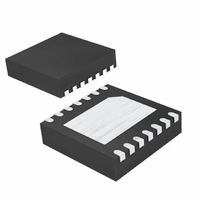MAX4919BETD+T Maxim Integrated Products, MAX4919BETD+T Datasheet - Page 8

MAX4919BETD+T
Manufacturer Part Number
MAX4919BETD+T
Description
IC CTLR OVP/OCP BATT PWR 14-TDFN
Manufacturer
Maxim Integrated Products
Datasheet
1.MAX4915AEUKT.pdf
(11 pages)
Specifications of MAX4919BETD+T
Applications
*
Mounting Type
Surface Mount
Package / Case
14-TDFN Exposed Pad
Lead Free Status / RoHS Status
Lead free / RoHS Compliant
100mA/200mA/300mA Current-Limit Switches
with Low Shutdown Reverse Current
When the forward or reverse current-limit threshold is
exceeded, the t
resets if the overcurrent condition disappears before
t
current condition continues up to the end of the blank-
ing time. Reset the switch by either toggling ON (Figure
3a) or cycling the input voltage below UVLO, typically
2V (Figure 3b).
All devices feature 14ms (min) fault blanking. Fault
blanking allows current-limit faults, including momentary
short-circuit faults that occur when hot-swapping a
capacitive load, and also ensures that no fault is issued
during power-up. When a load transient causes the
Figure 3. MAX4914B/MAX4915B/MAX4917B Latchoff Fault
Blanking
8
BLANK
CURRENT
FLAG PIN
FLAG PIN
VOLTAGE
CURRENT
FIGURE 3a
VOLTAGE
FIGURE 3b
SWITCH
STATUS
STATUS
STATUS
SWITCH
STATUS
_______________________________________________________________________________________
ON PIN
IN PIN
LOAD
LOAD
has elapsed. The switch is shut off if the over-
OFF
OFF
ON
ON
(MAX4914B/MAX4915B/MAX4917B)
BLANK
t
BLANK
t
BLANK
timer begins counting. The timer
UVLO
t
BLANK
t
BLANK
Fault Blanking
Latchoff
device to enter current limit, an internal counter starts. If
the load-transient fault persists beyond the fault-blank-
ing timeout, FLAG asserts low. Load-transient faults less
than t
current-limit faults are blanked.
A thermal fault and input voltage drops below the UVLO
threshold cause FLAG to assert immediately and not
wait for the blanking time.
The MAX4914B/MAX4915A/B/MAX4917A/B have a ther-
mal-shutdown feature to protect the devices from over-
heating. The switch turns off and FLAG goes low
immediately (no fault blanking) when the junction temper-
ature exceeds +150°C. The switch turns back on when
the device temperature drops approximately by 15°C.
To limit the input-voltage drop during momentary output
short-circuit conditions, connect a capacitor from IN to
GND. A 0.1µF ceramic capacitor is adequate for most
applications; however, higher capacitor values further
reduce the voltage drop at the input and are recom-
mended for lower voltage applications.
Connect a 0.1µF capacitor from OUT to GND. This
capacitor helps prevent inductive parasitics from
pulling OUT negative during turn-off, thus preventing
the devices from tripping erroneously. If the load
capacitance is too large, the current may not have
enough time to charge the capacitance and the device
assumes that there is a faulty load condition. The maxi-
mum capacitive load value that can be driven from
OUT is obtained by the following formula:
To optimize the switch response time to output short-
circuit conditions, it is very important to keep all traces
as short as possible to reduce the effect of undesirable
parasitic inductance. Place input and output capacitors
as close as possible to the device (no more than 5mm).
IN and OUT pins must be connected with short traces
to the power bus.
During normal operation, the power dissipation is small
and the package temperature change is minimal. If the
output is continuously shorted to ground at the maximum
BLANK
C
MAX
do not cause a FLAG output assertion. Only
Layout and Thermal Dissipation
Applications Information
<
I
FWD MIN
_
×
Output Capacitance
V
IN
Thermal Shutdown
t
BLANK MIN
Input Capacitor
_











